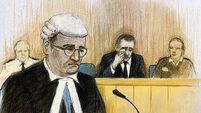Endure to explore

WHEN the Endurance set off 100 years ago, almost to the day, with the aim of crossing the Antarctic from sea-to-sea, chances are crewman Tom Crean never foresaw a time when his name would grace cans of lager. On the other hand, that may well have been exactly the kind of fame team leader Ernest Shackleton was expecting. What a difference a century makes.
Crean, the steely Kerryman from Annascaul, has become a paragon of Irish masculinity, his craggy features popping up all over the place — even on bottles of craft beer. Shackleton, also born in Ireland, doesn’t have anything like the same ubiquity, despite his role as one of the great figures in the age of polar exploration and his preternatural leadership skills. However, that could be about to change.
Author Michael Smith, author of Tom Crean: Antarctic Explorer, has written a new biography of ‘the Boss’ — and he also believes it is time Ireland reclaimed Shackleton as one of our own.
“Shackleton, to be fair, did always say that he was Irish, but I would say one of the things about Shackleton — he’s a man of great paradoxes,” Smith says. “He’s such a contradictory figure in almost everything that he does. For one thing, he says ‘I’m Irish and very proud of it’, but at one stage he stands as an MP on the ticket of a political party whose only platform issue is ‘no home rule for Ireland’. And he stands in Dundee, which happens to have very large Irish population.
“There were two Shackletons, two very different men,” he continues. “The fella on the ice, and the fella at home.” It is these two disparate sides to Shackleton that powers Smith’s biography, remarkably just the fourth on the man in the past 90 odd years.
Born in Athy, the young Ernest loved the rural life in Co Kildare but aged 10 his father moved the family to London, where at school Shackleton was called ‘Mickey’ because of his Irish accent.
Still in his mid-teens, he left school and set sale with the North Western Sailing Company out of Liverpool on an apprenticeship at the rank of Boy.
It was the beginning of the legend, with plenty of luck and grit along the way. A chance meeting on board one vessel with Lt Cedric Longstaff, whose father Llewellyn was a wealthy industrialist keen to plough money into polar exploration, resulted in Shackleton landing a spot on the Discovery voyage to Antarctica led by Captain Robert Falcon Scott, “the quintessential Englishman”. Shackleton was one of the three-man party that set a new ‘furthest south’, then later, on the Nimrod voyage, by which time he was in charge, he set another record, getting to within 97 miles of the South Pole. On his return he was feted by the public, but as Smith’s book illustrates, many in the British establishment still hadn’t taken to this brash, thrusting “gale of humanity”.
“Shackleton, throughout his life, was an outsider,” Smith says, pointing out that “he was too English in Ireland and too Irish in England”. Scott’s later doomed attempt at reaching the Pole, when he was beaten by Norwegian explorer, Roald Amundsen, sealed his legacy with the Edwardian public, yet Shackleton, who never lost a man despite the sometimes unreal setbacks they faced on the ice, was never as popular in the upper echelons of British society, despite his many obvious attributes. As Smith points out, Shackleton had a gift for selecting people to follow him on his adventures, “drifters” like Crean, and he then had the ability to inspire them to do extraordinary things. He led by example, by intuition and with a personal touch, far removed from the lofty bearing of men like Scott.
In spite of his shabby health, exacerbated by smoking and drinking, he defied death on numerous occasions, and his decision making under duress was truly remarkable.
According to Smith, “he seemed to come alive on the ice”, with purpose and clarity to the fore.
One famous example was the epic moments when the Endurance was slowly crushed by the ice, the crew helplessly watching on as it was dragged beneath the icy waters.
Shackleton gathered the men and said to them: “Boys, let’s go home”.
On the previous Nimrod expedition, with the Pole just 97 miles away, he decided to turn back, knowing that if he and his two colleagues continued they would never return.
“They made it back by the skin of their teeth,” Smith says, recalling how the doctor on board remarked how if they had taken another hour they would have died; one hour, following a journey of 1,760 miles. “That is a heartbeat,” Smith says. And yet, back in England, Ernest was something of a nowhere man, according to the author. “The contrast with Shackelton was so black and white — he was moody, restless, drunk, shagging, and then once he got on the ice, it was like Popeye with a can of spinach.
“He couldn’t hold down a job, he had quite a lot of affairs, he loved his family but on the other hand he couldn’t resist straying, and as a business man he was a complete joke. He was so bad, he was spectacularly bad.”
The book, written in a brisk, unfussy style, captures the duality of the man and is propelled by his burning sense of adventure. Shackleton died on his fourth voyage to the ice, and is buried in South Georgia, the scene of some of the extraordinary escapades undertaken by Crean and Shackleton some years earlier.
All this, and yet for years it seems he fell out of favour, and the limelight. As for the land of his birth, Smith believes it would be right for Ireland to now erect a statue of Shackleton to commemorate his remarkable life and achievements.
Crean is now an Irish icon; maybe Shackleton could be too. “It is a story of our times in many respects,” he says, adding that his buccaneering spirit will endure, even in our “very ordered times”. According to Smith, if he were alive today and announced a new voyage into some unknown sphere, “people would be killed in the rush to go with him”.











